Responses of Methane Emission and Bacterial Community to Fertilizer Reduction Plus Organic Materials over the Course of an 85-Day Leaching Experiment
Abstract
:1. Introduction
2. Materials and Methods
2.1. Design of Soil Column Leaching Experiment
2.2. Collections and Detections of the CH4 Fluxes
2.3. Topsoil DNA Extraction and High throughput Sequencing
2.4. Statistical Analysis
3. Results
3.1. Characteristics of Soil and Organic Materials Used in This Study
3.2. Changes of CH4 Emissions over the Course of an 85-Day Leaching Experiment
3.3. Variations of the Soil Bacterial Community Structure
3.4. Correlation of the Bacterial Communities to Environmental Factors
4. Discussion
4.1. Fertilizer Reduction Plus Organic Materials Accelerate the CH4 Emissions from the Flooded Paddy Soil
4.2. Potential Mechanism of CH4 Emission under Fertilizer Reduction Plus Organic Materials
4.3. Implication
5. Conclusions
Supplementary Materials
Author Contributions
Funding
Data Availability Statement
Conflicts of Interest
References
- Haque, M.M.; Sang, Y.K.; Ali, M.A.; Kim, P.J. Contribution of greenhouse gas emissions during cropping and fallow seasons on total global warming potential in mono-rice paddy soils. Plant Soil 2015, 387, 251–264. [Google Scholar] [CrossRef]
- Xu, Y.; Zhang, L.; Ou, S.; Wang, R.; Wang, Y.; Chu, C.; Yao, S. Natural variations of SLG1 confer high-temperature tolerance in indica rice. Nat. Commun. 2020, 11, 5441. [Google Scholar] [CrossRef] [PubMed]
- Neubauer, S.C.; Megonigal, J.P. Moving beyond global warming potentials to quantify the climatic role of ecosystems. Ecosystems 2015, 18, 1000–1013. [Google Scholar] [CrossRef]
- Ministry of Ecology and Environment of the People’s Republic of China. Available online: https://www.mee.gov.cn/ywgz/ydqhbh/wsqtkz/201907/P020190701765971866571.pdf (accessed on 25 March 2023).
- Wang, W.; Lai, D.Y.F.; Wang, C.; Pan, T.; Zeng, C. Effects of rice straw incorporation on active soil organic carbon pools in a subtropical paddy field. Soil Tillage Res. 2015, 152, 8–16. [Google Scholar] [CrossRef]
- Yao, Z.; Zheng, X.; Dong, H.; Wang, R.; Mei, B.; Zhu, J. A 3-year record of N2O and CH4 emissions from a sandy loam paddy during rice seasons as affected by different nitrogen application rates. Agric. Ecosyst. Environ. 2012, 152, 1–9. [Google Scholar] [CrossRef]
- Wang, Y.; Bai, R.; Di, H.J.; Mo, L.Y.; Han, B.; Zhang, L.M.; He, J.Z. Differentiated mechanisms of biochar mitigating straw-induced greenhouse gas emissions in two contrasting paddy soils. Front. Microbiol. 2018, 9, 2566. [Google Scholar] [CrossRef]
- Zhou, J.; Chen, H.; Tao, Y.; Thring, R.W.; Mao, J. Biochar amendment of chromium polluted paddy soil suppresses greenhouse gas emissions and decreases chromium uptake by rice grain. J. Soils Sediments 2019, 19, 1756–1766. [Google Scholar] [CrossRef]
- Pan, F.F.; Yu, W.T.; Ma, Q.; Zhou, H.; Jiang, C.M.; Xu, Y.G.; Ren, J.F. Influence of 15N-labeled ammonium sulfate and straw on nitrogen retention and supply in different fertility soils. Biol. Fertil. Soils 2017, 53, 303–313. [Google Scholar] [CrossRef]
- Sun, J.; Peng, H.; Chen, J.; Wang, X.; Wei, M.; Li, W.; Yang, L.; Zhang, Q.; Wang, W.; Mellouki, A. An estimation of CO2 emission via agricultural crop residue open field burning in China from 1996 to 2013. J. Clean. Prod. 2016, 112, 2625–2631. [Google Scholar] [CrossRef]
- Zhang, J.W.; Tang, H.Y.; Zhu, J.G.; Lin, X.G.; Feng, Y.Z. Divergent responses of methanogenic archaeal communities in two rice cultivars to elevated ground-level O3. Environ. Pollut. 2016, 213, 127–134. [Google Scholar] [CrossRef] [PubMed]
- Wu, X.H.; Wang, W.; Xie, K.J.; Yin, C.M.; Hou, H.J.; Xie, X.L. Combined effects of straw and water management on CH4 emissions from rice fields. J. Environ. Manag. 2019, 231, 1257–1262. [Google Scholar] [CrossRef] [PubMed]
- Ye, R.Z.; Horwath, W.R. Influence of rice straw on priming of soil C for dissolved organic C and CH4 production. Plant Soil 2017, 417, 231–241. [Google Scholar] [CrossRef]
- Wang, H.; Li, X.; Li, X.; Wang, J.; Li, X.; Guo, Q.; Yu, Z.; Yang, T.; Zhang, H. Long-term no-tillage and different residue amounts alter soil microbial community composition and increase the risk of maize root rot in northeast China. Soil Till Res. 2020, 196, 104452. [Google Scholar] [CrossRef]
- Liu, B.; Xia, H.; Jiang, C.; Riaz, M.; Yang, L.; Chen, Y.; Fan, X.; Xia, X. 14 year applications of chemical fertilizers and crop straw effects on soil labile organic carbon fractions, enzyme activities and microbial community in rice-wheat rotation of middle China. Sci. Total Environ. 2022, 841, 156608. [Google Scholar] [CrossRef]
- Wang, X.; Sun, B.; Mao, J.; Sui, Y.; Cao, X. Structural convergence of maize and wheat straw during two-year decomposition under different climate conditions. Environ. Sci. Technol. 2012, 46, 7159–7165. [Google Scholar] [CrossRef]
- Jiang, Y.; van Groenigen, K.J.; Huang, S.; Hungate, B.A.; van Kessel, C.; Hu Liechty, Z.; Santos-Medellín, C.; Edwards, J.; Nguyen, B.; Mikhail, D.; et al. Comparative analysis of root microbiomes of rice cultivars with high and low methane emissions reveals differences in abundance of methanogenic archaea and putative upstream fermenters. mSystems 2020, 5, e819–e897. [Google Scholar]
- Pump, J.; Pratscher, J.; Conrad, R. Colonization of rice roots with methanogenic archaea controls photosynthesis-derived methane emission. Environ. Microbiol. 2015, 17, 2254–2260. [Google Scholar] [CrossRef]
- Hofmann, K.; Praeg, N.; Mutschlechner, M.; Wagner, A.O.; Illmer, P. Abundance and potential metabolic activity of methanogens in well-aerated forest and grassland soils of an alpine region. FEMS Microbiol. Ecol. 2016, 92, fiv171. [Google Scholar] [CrossRef]
- Yang, Y.-L.; Shen, L.-D.; Zhao, X.; Shan, J.; Wang, S.-W.; Zhou, W.; Liu, J.-Q.; Liu, X.; Tian, M.-H.; Yang, W.-T.; et al. Long-term incorporation of wheat straw changes the methane oxidation potential, abundance and community composition of meth-anotrophs in a paddy ecosystem. Appl. Soil Ecol. 2022, 173, 1043. [Google Scholar] [CrossRef]
- Gütlein, A.; Gerschlauer, F.; Kikoti, I.; Kiese, R. Impacts of climate and land use on N2O and CH4 fluxes from tropical ecosystems in the Mt. Kilimanjaro region, Tanzania. Glob. Chang. Biol. 2018, 24, 1239–1255. [Google Scholar] [CrossRef]
- Qi, L.; Pokharel, P.; Huang, R.; Chang, S.X.; Gong, X.Q.; Sun, T.; Wu, Y.Q.; Wang, Z.F.; Gao, M. Crop residue retention increases greenhouse gas emissions but reduces chemical fertilizer requirement in a vegetable-rice rotation. Agric. For. Meteorol. 2023, 342, 109723. [Google Scholar] [CrossRef]
- Jiang, Y.; Qian, H.Y.; Huang, S.; Zhang, X.Y.; Wang, L.; Zhang, L.; Shen, M.X.; Xiao, X.P.; Chen, F.; Zhang, H.L.; et al. Acclimation of methane emissions from rice paddy fields to straw addition. Sci. Adv. 2019, 5, eaau9038. [Google Scholar] [CrossRef] [PubMed]
- Blanca Pascual, M.; Sánchez-Monedero, M.A.; Chacón, F.J.; Sánchez-García, M.; Cayuela, M.L. Linking biochars properties to their capacity to modify aerobic CH4 oxidation in an upland agricultural soil. Geoderma 2020, 363, 114179. [Google Scholar] [CrossRef]
- Luo, D.; Li, Y.Y.; Yao, H.Y.; Chapman, S.J. Effect of different carbon sources on methane production and the methanogenic communities in iron rich flooded paddy soil. Sci. Total Environ. 2022, 823, 153636. [Google Scholar] [CrossRef] [PubMed]
- He, C.; Yang, Z.L.; Huang, G.Q.; Chen, L.J.; Han, L.J. Qualitative and quantitative analysis of straw content in straw-coal blends using vis/nir spectroscopy. Trans. Chin. Soc. Agric. Eng. 2013, 29, 188–195. [Google Scholar]
- Gao, J.K.; Liang, C.L.; Shen, G.Z.; Lv, J.L.; Wu, H.M. Spectral characteristics of dissolved organic matter in various agricultural soils throughout China. Chemosphere 2017, 176, 108–116. [Google Scholar] [CrossRef]
- Fellman, J.B.; Hood, E.; Spencer, R.G. Fluorescence spectroscopy opens new windows into dissolved organic matter dynamics in freshwater ecosystems: A review. Limnol. Oceanogr. 2010, 55, 2452–2462. [Google Scholar] [CrossRef]
- Zsolnay, Á. Dissolved organic matter: Artefacts, definitions, and functions. Geoderma 2003, 113, 187–209. [Google Scholar] [CrossRef]
- Li, W.; Li, X.; Han, C.; Gao, L.; Wu, H.; Li, M. A new view into three−dimensional excitation−emission matrix fluorescence spectroscopy for dissolved organic matter. Sci. Total Environ. 2023, 855, 158963. [Google Scholar] [CrossRef]
- Gao, J.; Liu, L.; Shi, Z.; Lv, J. Biochar Amendments Facilitate Methane Production by Regulating the Abundances of Methanogens and Methanotrophs in Flooded Paddy Soil. Front. Soil Sci. 2022, 2, 801227. [Google Scholar] [CrossRef]
- Wu, J.; Zhang, J.; Jia, W. Impact of COD/N ratio on nitrous oxide emission from microcosm wetlands and their performance in removing nitrogen from wastewater. Bioresour. Technol. 2009, 100, 2910–2917. [Google Scholar] [CrossRef] [PubMed]
- Munyaka, P.M.; Khafipour, A.; Wang, H.; Eissa, N.; Khafipour, E.; Ghia, J.E. Mo1774 Prenatal Antibiotic Treatment Increases Offspring’s Susceptibility to Experimental Colitis: A Role of the Gut Microbiota. PLoS ONE 2015, 10, e0142536. [Google Scholar] [CrossRef]
- Jami, E.; Israel, A.; Kotser, A.; Mizrahi, I. Exploring the bovine rumen bacterial community from birth to adulthood. ISME J. 2013, 7, 1069–1079. [Google Scholar] [CrossRef]
- Liu, D.; Huang, Y.M.; An, S.S.; Sun, H.Y.; Bhople, P.; Chen, Z.W. Soil physicochemical and microbial characteristics of contrasting land-use types along soil depth gradients. Catena 2017, 162, 345–353. [Google Scholar] [CrossRef]
- Qin, H.L.; Tang, Y.F.; Shen, J.L.; Wang, C.; Chen, C.L.; Yang, J.; Liu, Y.; Chen, X.B.; Li, Y.; Hou, H.J. Abundance of transcripts of functional gene reflects the inverse relationship between CH4 and N2O emissions during mid-season drainage in acidic paddy soil. Biol. Fertil. Soils 2018, 54, 885–895. [Google Scholar] [CrossRef]
- Wang, W.; Chen, C.L.; Wu, X.H.; Xie, K.J.; Yin, C.M.; Hou, H.J.; Xie, X.L. Effects of reduced chemical fertilizer combined with straw retention on greenhouse gas budget and crop production in double rice fields. Biol. Fertil. Soils 2019, 55, 89–96. [Google Scholar] [CrossRef]
- Liu, H.; Hu, Z.; Zhang, J.; Ngo, H.H.; Guo, W.; Liang, S. Optimizations on supply and distribution of dissolved oxygen in constructed wetlands: A review. Bioresour. Technol. 2016, 214, 797–805. [Google Scholar] [CrossRef] [PubMed]
- Hu, N.J.; Wang, B.J.; Gu, Z.H.; Tao, B.R.; Zhang, Z.W.; Hu, S.J.; Zhu, L.Q.; Meng, Y.L. Effects of different straw returning modes on greenhouse gas emissions and crop yields in a rice-wheat rotation system. Agric. Ecosyst. Environ. 2016, 223, 115–122. [Google Scholar] [CrossRef]
- Wang, C.; Liu, J.; Shen, J.; Chen, D.; Li, Y.; Jiang, B.; Wu, J. Effects of bio-char amendment on net greenhouse gas emissions and soil fertility in a double rice cropping system: A 4-year field experiment. Agric. Ecosyst. Environ. 2018, 262, 83–96. [Google Scholar] [CrossRef]
- Wu, Z.; Sun, L.; Dong, Y.; Xu, X.; Xiong, Z. Contrasting effects of different field-aged biochars on potential methane oxidation between acidic and saline paddy soils. Sci. Total Environ. 2022, 853, 158643. [Google Scholar] [CrossRef]
- Jiang, Y.; van Groenigen, K.J.; Huang, S.; Hungate, B.A.; van Kessel, C.; Hu, S.J.; Zhang, J.; Wu, L.H.; Yan, X.J.; Wang, L.L.; et al. Higher yields and lower methane emissions with new rice cultivars. Glob. Chang. Biol. 2017, 23, 4728–4738. [Google Scholar] [CrossRef] [PubMed]
- Wu, X.; Wang, W.; Xie, X.; Yin, C.; Hou, H.; Yan, W.; Wang, G. Net global warming potential and greenhouse gas intensity as affected by different water management strategies in Chinese double rice cropping systems. Sci. Rep. 2018, 8, 779. [Google Scholar] [CrossRef] [PubMed]
- Huang, S.; Sun, Y.; Yu, X.; Zhang, W. Interactive effects of temperature and moisture on CO2 and CH4 production in a paddy soil under long-term different fertilization regimes. Biol Fertil Soils 2016, 52, 285–294. [Google Scholar] [CrossRef]
- Zhou, M.; Zhu, B.; Wang, X.; Wang, Y. Long-term field measurements of annual methane and nitrous oxide emissions from a Chinese subtropical wheat-rice rotation system. Soil Biol. Biochem. 2017, 115, 21–34. [Google Scholar] [CrossRef]
- Zhang, Y.; Xu, X.; Zhang, P.; Ling, Z.; Qiu, H.; Cao, X. Pyrolysis-temperature depended quinone and carbonyl groups as the electron accepting sites in barley grass derived biochar. Chemosphere 2019, 232, 273–280. [Google Scholar] [CrossRef]
- Li, X.M.; Ding, L.J.; Li, X.M.; Zhu, Y.G. Abundance, diversity, and structure of geobacteraceae community in paddy soil under long-term fertilization practices. Appl. Soil Ecol. 2020, 153, 103577. [Google Scholar] [CrossRef]
- Li, D.D.; Zhao, B.Z.; Zhang, J.B.; Liu, K.L.; Huang, Q.H. Different traits from the paddy soil and upland soil regulate bacterial community and molecular composition under long-term fertilization regimes. Appl. Soil Ecol. 2021, 165, 103982. [Google Scholar] [CrossRef]
- Meier, K.K.; Jones, S.M.; Kaper, T.; Hansson, H.; Koetsier, M.J.; Karkehabadi, S.; Solomon, E.I.; Sandgren, M.; Kelemen, B. Oxygen activation by Cu LPMOs in recal-citrant carbohydrate polysaccharide conversion to monomer sugars. Chem. Rev. 2018, 118, 2593–2635. [Google Scholar] [CrossRef]
- Björn, B.; Martin, B.B.; Melanie, K.; Ralf, C. Croprotation of flooded rice with upland maize impacts the resident and active methanogenic microbial community. Environ. Microbiol. 2015, 18, 2868–2885. [Google Scholar]
- Conrad, R. Microbial ecology of methanogens and methanotrophs. Adv. Agron. 2007, 96, 1–63. [Google Scholar]
- Azeem, M.; Hayat, R.; Hussain, Q.; Ahmed, M.; Imran, M.; Crowley, D.E. Effect of biochar amendment on soil microbial biomass abundance enzyme activity in the mash bean field. J. Biod. Environ. Sci. 2016, 8, 2222–3045. [Google Scholar]
- Watanabe, T.; Kimura, M.; Asakawa, S. Community structure of methanogenic archaea in paddy field soil under double cropping (rice–wheat). Soil Biol. Biochem. 2006, 38, 1264–1274. [Google Scholar] [CrossRef]
- Ji, Y.; Liu, P.; Conrad, R. Change of the pathway of methane production with progressing anoxic incubation of paddy soil. Soil Biol. Biochem. 2018, 121, 177–184. [Google Scholar] [CrossRef]
- Rui, J.; Peng, J.; Lu, Y. Succession of Bacterial Populations during Plant Residue De-composition in Rice Field Soil. Appl. Environ. Microbiol. 2009, 75, 4879–4886. [Google Scholar] [CrossRef] [PubMed]
- Hernández, M.; Conrad, R.; Klose, M.; Ma, K.; Lu, Y. Structure and function of methanogenic microbial communities in soils from flooded rice and upland soybean fields from Sanjiang Plain, NE China. Soil Biol. Biochem. 2017, 105, 81–91. [Google Scholar] [CrossRef]
- Yuan, J.; Yuan, Y.; Zhu, Y.; Cao, L. Effects of different fertilizers on methane emissions and methanogenic community structures in paddy rhizosphere soil. Sci. Total Environ. 2018, 627, 770–781. [Google Scholar] [CrossRef] [PubMed]
- Fan, L.; Dippold, M.A.; Ge, T.; Wu, J.; Thiel, V.; Kuzyakov, Y.; Dorodnikov, M. Anaerobic oxidation of methane in paddy soil: Role of electron acceptors and fertilization in mitigating ch4 fluxes. Soil Biol. Biochem. 2020, 141, 107685. [Google Scholar] [CrossRef]
- Zhang, Y.; Wang, F.; Jia, Z. Electron shuttles facilitate anaerobic methane oxidation coupled to nitrous oxide reduction in paddy soil. Soil Biol. Biochem. 2021, 153, 108091. [Google Scholar] [CrossRef]

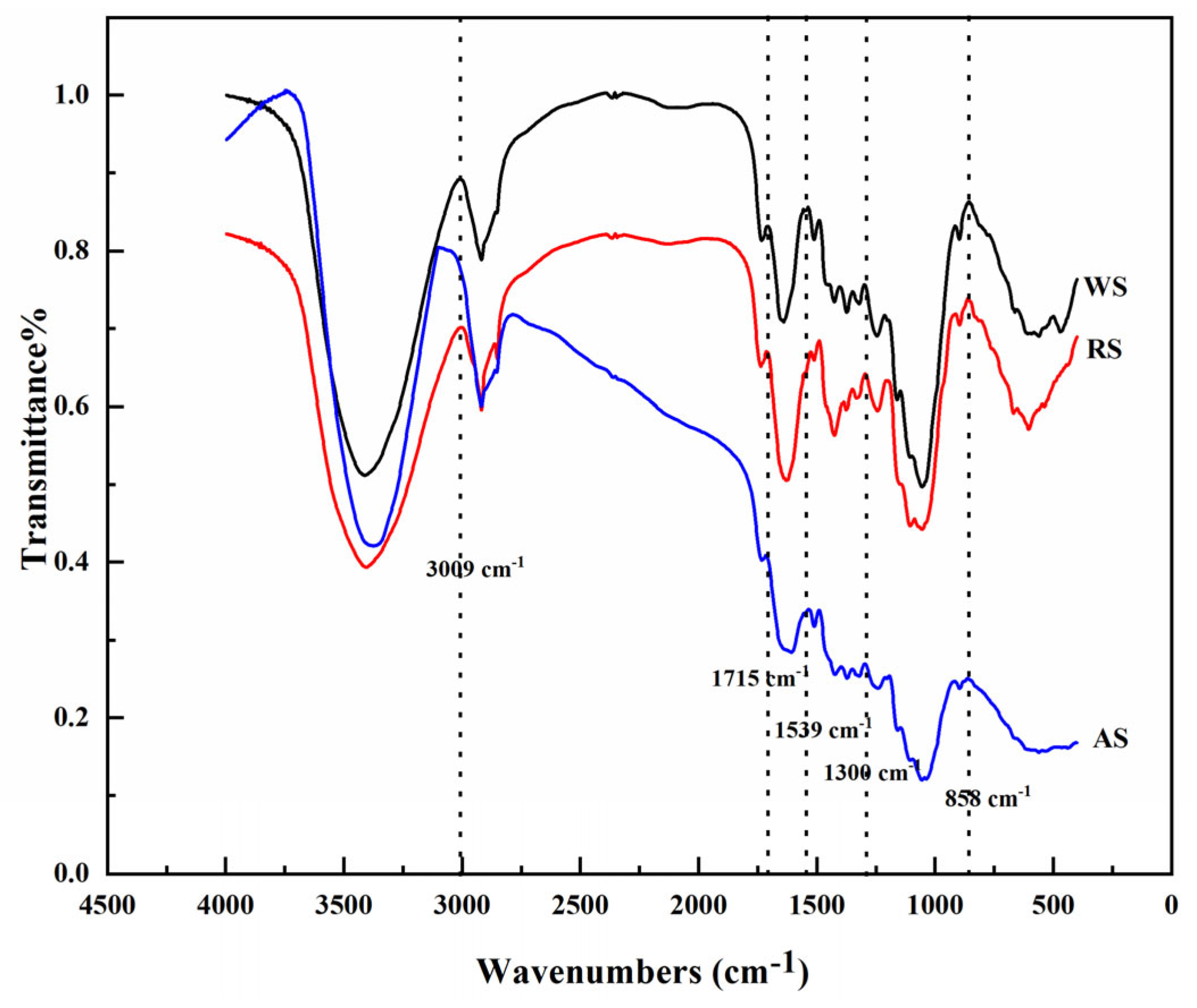
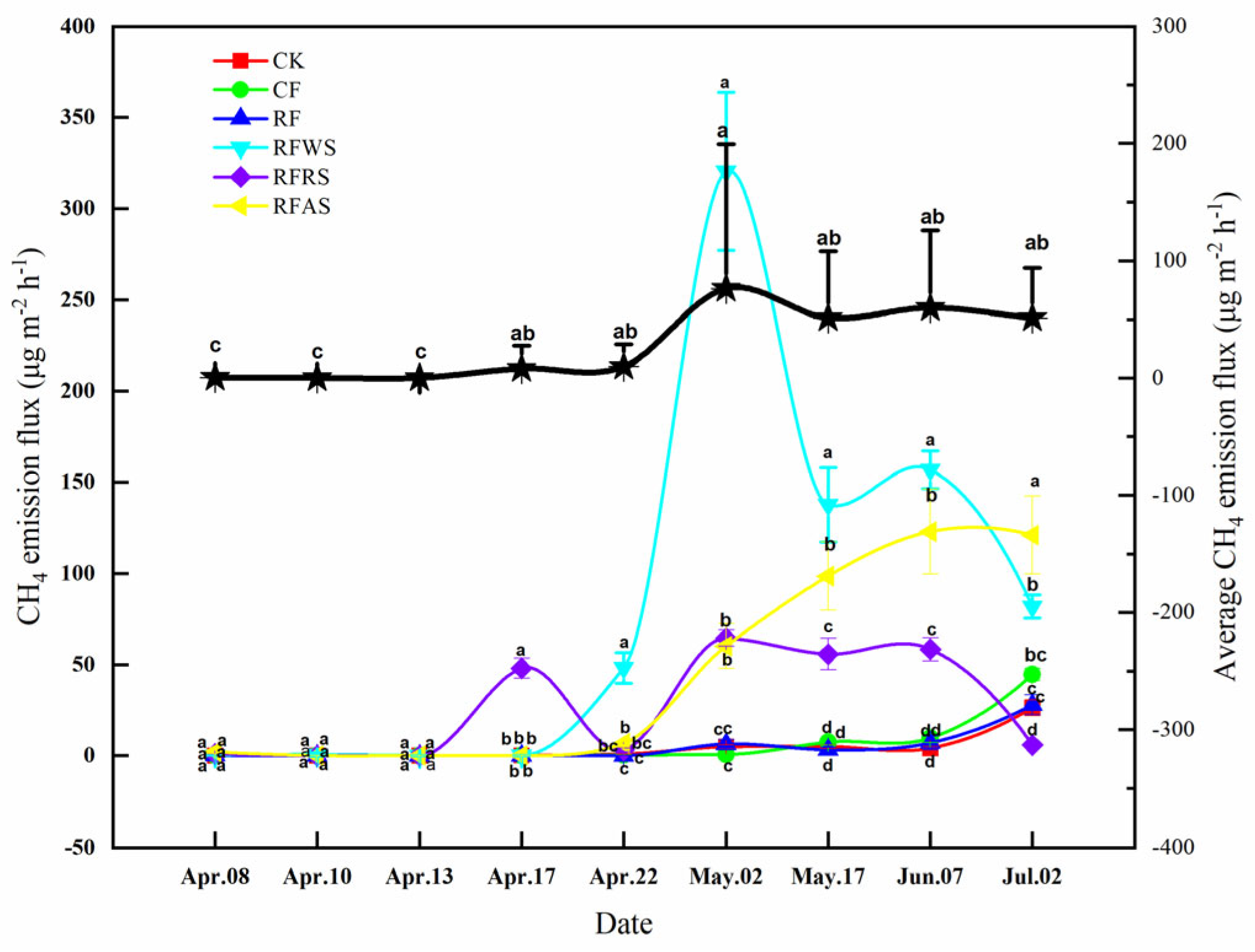
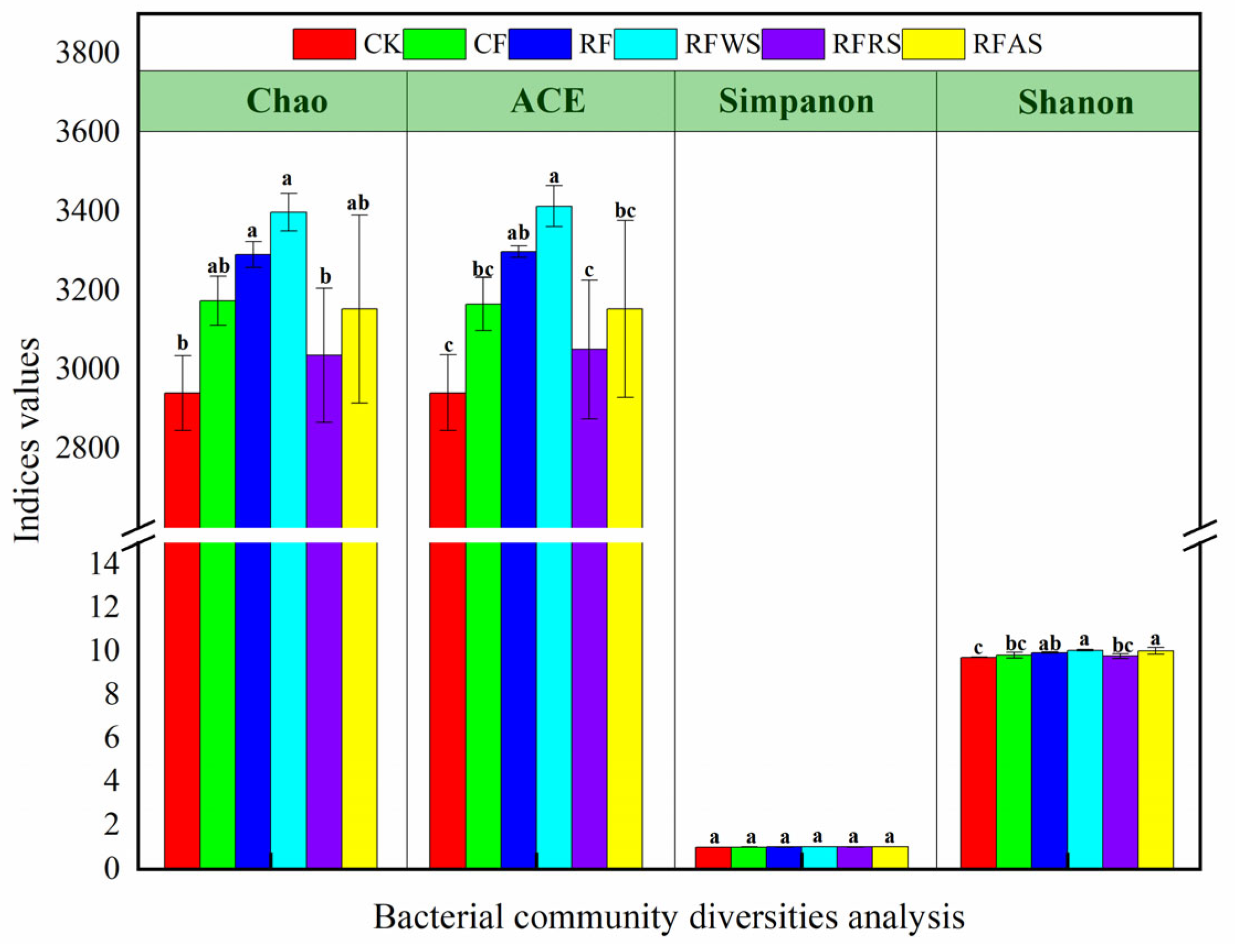

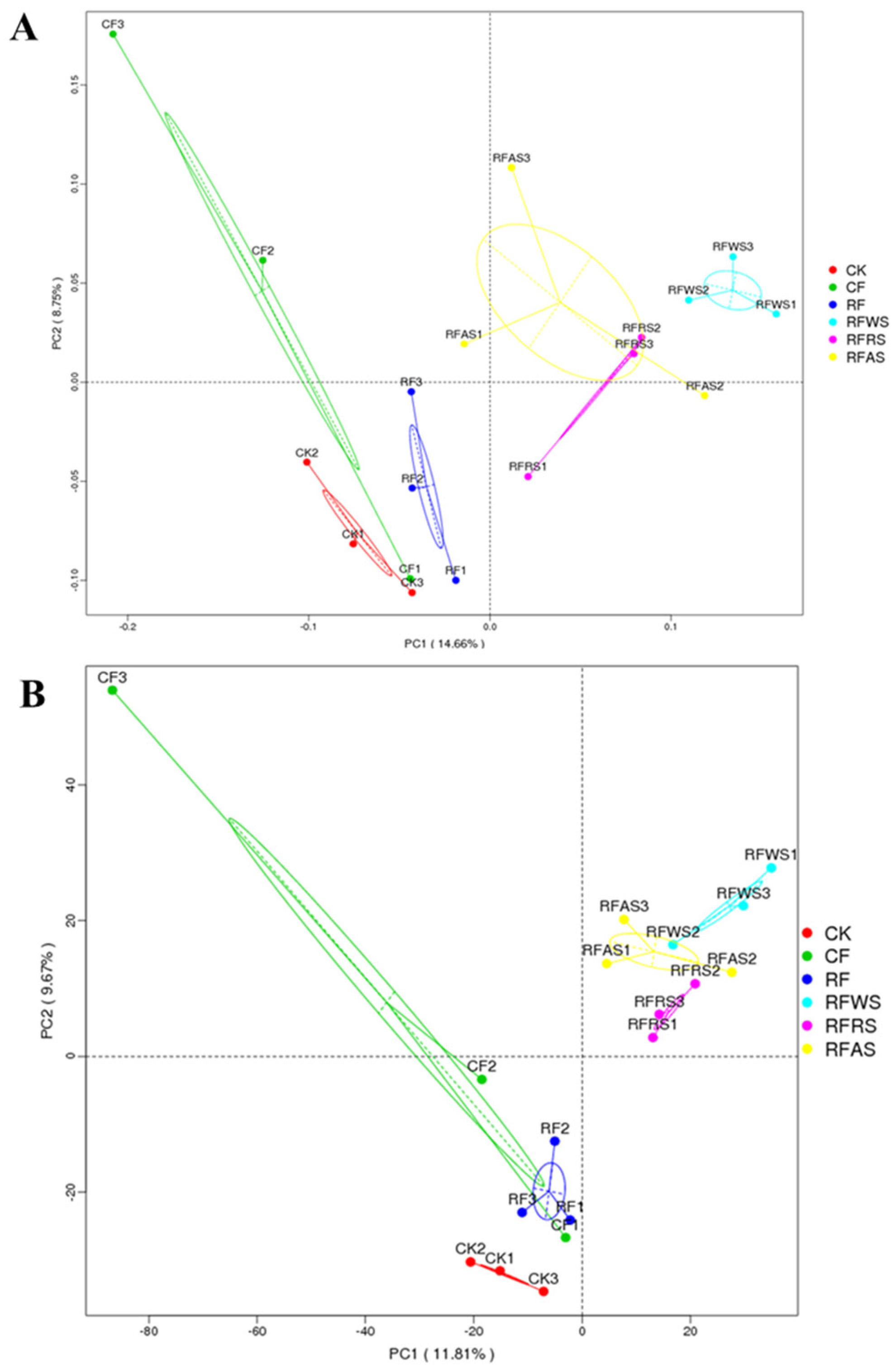
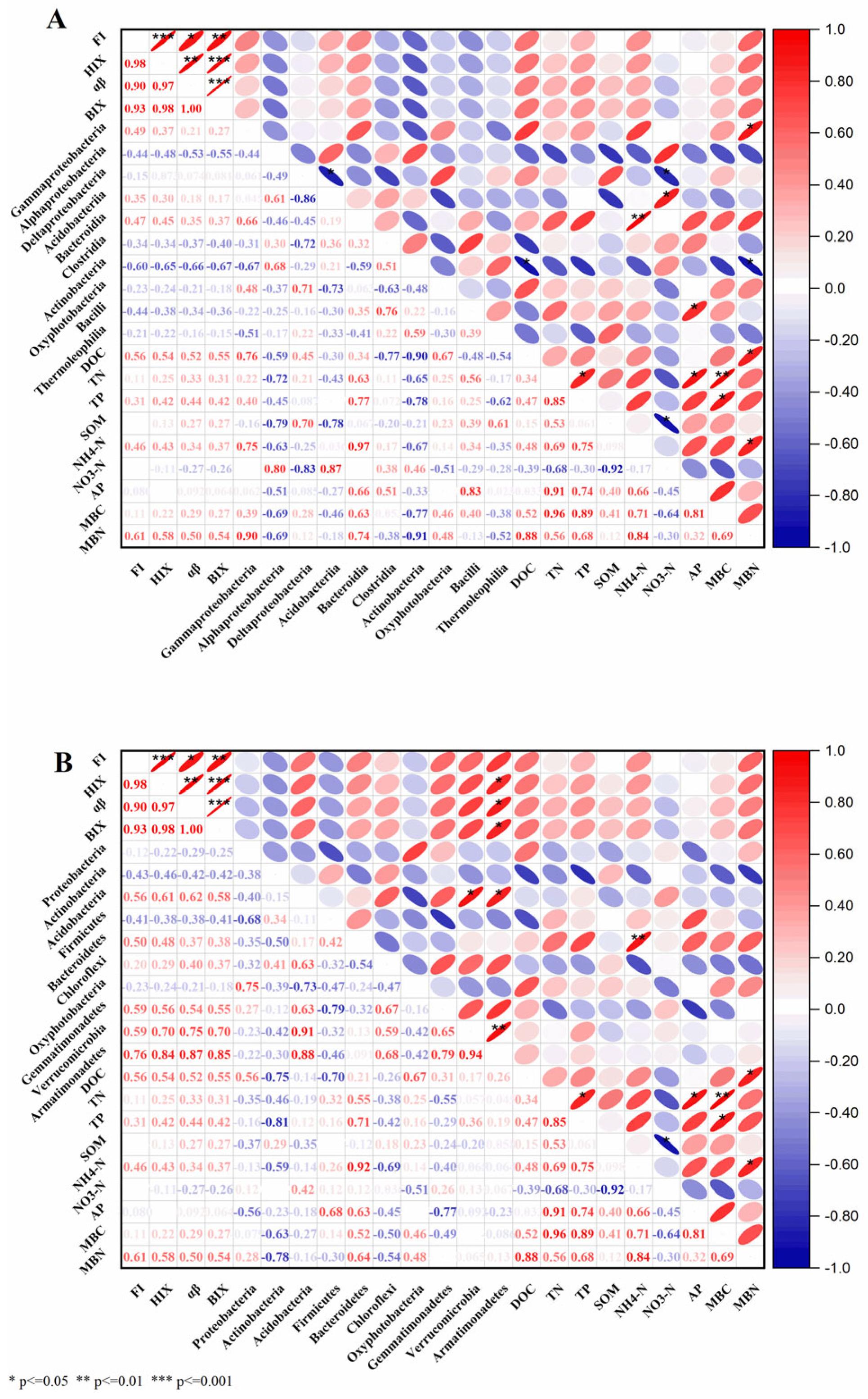
| Depth (cm) | pH | SOM (g kg−1) | AK (mg kg−1) | AP (mg kg−1) | CEC (cmol kg−1) | TN (g kg−1) |
|---|---|---|---|---|---|---|
| 10 | 7.38 ± 0.21 b | 32.22 ± 0.44 a | 130.40 ± 1.21 a | 20.12 ± 0.61 a | 18.60 ± 0.22 a | 1.21 ± 0.10 a |
| 20 | 7.59 ± 0.11 ab | 24.58 ± 0.51 b | 59.10 ± 4.21 b | 13.80 ± 1.81 b | 20.18 ± 2.81 a | 1.24 ± 0.17 a |
| 30 | 7.63 ± 0.02 a | 10.97 ± 1.09 c | 39.61 ± 1.10 c | 7.55 ± 0.37 c | 19.87 ± 3.61 a | 0.39 ± 0.05 b |
| 40 | 7.72 ± 0.03 a | 6.53 ± 0.41 d | 38.23 ± 1.11 c | 5.66 ± 0.32 c | 18.31 ± 1.31 a | 0.26 ± 0.03 b |
Disclaimer/Publisher’s Note: The statements, opinions and data contained in all publications are solely those of the individual author(s) and contributor(s) and not of MDPI and/or the editor(s). MDPI and/or the editor(s) disclaim responsibility for any injury to people or property resulting from any ideas, methods, instructions or products referred to in the content. |
© 2024 by the authors. Licensee MDPI, Basel, Switzerland. This article is an open access article distributed under the terms and conditions of the Creative Commons Attribution (CC BY) license (https://creativecommons.org/licenses/by/4.0/).
Share and Cite
Gao, J.; Ma, Z.; Liu, L.; Shi, Z.; Lv, J. Responses of Methane Emission and Bacterial Community to Fertilizer Reduction Plus Organic Materials over the Course of an 85-Day Leaching Experiment. Agronomy 2024, 14, 1972. https://doi.org/10.3390/agronomy14091972
Gao J, Ma Z, Liu L, Shi Z, Lv J. Responses of Methane Emission and Bacterial Community to Fertilizer Reduction Plus Organic Materials over the Course of an 85-Day Leaching Experiment. Agronomy. 2024; 14(9):1972. https://doi.org/10.3390/agronomy14091972
Chicago/Turabian StyleGao, Jiakai, Zhenyi Ma, Ling Liu, Zhaoyong Shi, and Jialong Lv. 2024. "Responses of Methane Emission and Bacterial Community to Fertilizer Reduction Plus Organic Materials over the Course of an 85-Day Leaching Experiment" Agronomy 14, no. 9: 1972. https://doi.org/10.3390/agronomy14091972




